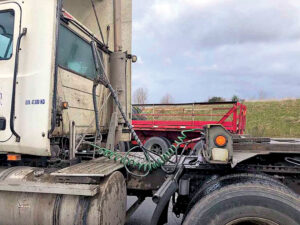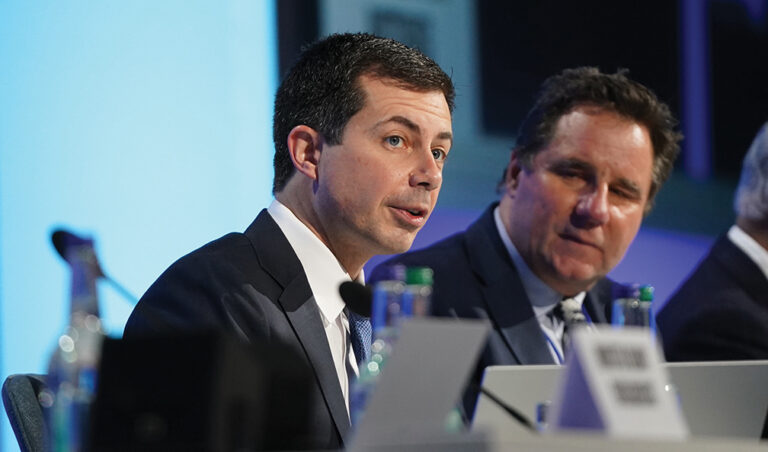Sometimes, the news coming out of the nation’s capital is good, sometimes not so good, and sometimes it’s just bad. The latter was the case recently, as it involves traffic fatalities, including those involving large trucks. First, the U.S. Department of Transportation (DOT) reported a spike in traffic fatalities in the first half of 2021. Second, the Federal Motor Carrier Safety Administration (FMCSA) said fatal wrecks involving large trucks are increasing. While on the subject of these two entities, in this edition of Capitol Recap we’ll share more about how FMCSA Deputy Administrator Meera Joshi convened a stakeholder meeting in the Midwest to discuss truck driving and supply-chain issues and cybersecurity flaws the U.S. Department of Transportation identified on servers belonging to the agency. Keeping with the safety-related issues, the Commercial Vehicle Safety Alliance released its brake safety week results.
Recent reports show traffic fatality spike, more trucks involved in fatal crashes
The National Highway Traffic Safety Administration (NHTSA) and the Federal Motor Carrier Safety Administration (FMCSA) recently released safety-related data concerning fatal accidents.
NHTSA revealed the Early Estimate of Motor Vehicle Traffic Fatalities for January-June, which shows the largest six-month increase ever recorded in the Fatality Analysis Reporting System’s (FARS) history.
The FMCSA said in the recently updated Large Truck and Bus facts that in 2019, 5,237 large trucks and buses were involved in fatal crashes, a 2% increase from 2018. The FMCSA defines large trucks as weighing more than 10,000 pounds.
NHTSA said an estimated 20,160 people died in motor vehicle crashes in the first half of 2021, up 18.4% over 2020. That’s the largest number of projected fatalities in that time period since 2006.
“This is a crisis. More than 20,000 people died on U.S. roads in the first six months of 2021, leaving countless loved ones behind. We cannot and should not accept these fatalities as simply a part of everyday life in America,” said Transportation Secretary Pete Buttigieg. “Today we are announcing that we will produce the department’s first ever National Roadway Safety Strategy to identify action steps for everyone working to save lives on the road. No one will accomplish this alone. It will take all levels of government, industries, advocates, engineers, and communities across the country working together toward the day when family members no longer have to say goodbye to loved ones because of a traffic crash.”
In addition to the traffic fatality data, NHTSA also released behavioral research findings from March 2020 through June 2021, indicating that incidents of speeding and traveling without a seatbelt remain higher than during pre-pandemic times.
Preliminary data from the Federal Highway Administration show that vehicle miles traveled (VMT) in the first half of 2021 increased by about 173.1 billion miles, or about 13%. The fatality rate for the first half of 2021 increased to 1.34 fatalities per 100 million VMT, up from the projected rate of 1.28 fatalities per 100 million VMT in the first half of 2020.
The FMCSA said that from 2018 to 2019, large truck and bus fatalities per 100 million vehicle miles traveled by all motor vehicles declined from 0.162 to 0.161, 21% below the 21st-century peak of 0.205 in 2000.
There was a 34% decrease in the number of fatal crashes involving large trucks or buses between 2005 and 2009, followed by an increase of 47% between 2009 and 2019, the report states.
From 2018 to 2019, the number of fatal crashes involving large trucks or buses increased by less than 1%.
Of the 4,949 drivers of large trucks involved in fatal crashes in 2019, 354 (7%) were 25 years of age or younger, and 361 (7%) were 66 years of age or older.
In 2019, 13% (795) of large truck occupants in fatal crashes were not wearing a safety belt, of which 337 (42%) were killed in the crash. In contrast, only 393 (8%) of the 4,712 large truck occupants wearing safety belts in fatal crashes were killed. Nine percent of the 4,949 drivers of large trucks involved in fatal crashes (454) were not wearing a safety belt at the time of the crash.
Study grades states on infrastructure quality

North Dakota, Virginia, Missouri, Kentucky, and North Carolina have the most cost-effective highway systems, according to the Annual Highway Report published in November by the Reason Foundation, a nonprofit think tank.
New Jersey, Rhode Island, Alaska, Hawaii, and New York have the worst combination of highway performance and cost-effectiveness, the study found.
The Annual Highway Report measures the condition and cost-effectiveness of state-controlled highways in 13 categories, including urban and rural pavement condition, deficient bridges, traffic fatalities, spending per mile, and administrative costs per mile of highway.
A number of states with large populations and busy highways performed well in the overall rankings, including Virginia (second overall), Missouri (third), North Carolina (fifth), Georgia (14th), and Texas (16th).
Nationally, the study found America’s highway system is incrementally improving in almost every category. However, a 10-year average indicates the nation’s highway system problems are concentrated in the bottom 10 states and, despite spending more money, these worst-performing states are finding it difficult to improve.
For example, 43% of the urban arterial primary mileage in poor condition is in six states — California, Massachusetts, New York, New Jersey, Nebraska, and Rhode Island. Approximately 25% of the rural interstate mileage in poor condition is in just three states (Alaska, Colorado, and Washington).
While a majority of states reduced their percentages of structurally deficient bridges, five states — Rhode Island, West Virginia, Iowa, South Dakota, and Pennsylvania — still report more than 15% of their bridges as deficient.
For total spending, three states — Massachusetts, New York, and New Jersey — spent more than $250,000 per lane-mile of highway. In contrast, five states — Missouri, South Carolina, West Virginia, North Dakota, and South Dakota — spent less than $30,000 per mile of highway.
“States need to ensure their highway spending produces safer roads, smoother pavement, fewer deficient bridges, and less traffic congestion,” said the Annual Highway Report’s Lead Author Baruch Feigenbaum. “The states with the best overall rankings maintain better-than-average highways with relatively efficient spending per mile.”
Midwest meetings focus on trucking, supply chain

Continuing what she called the Biden administration’s whole-of-government approach to addressing supply chain disruptions, Federal Motor Carrier Safety Administration (FMCSA) Deputy Administrator Meera Joshi met with multiple transportation organizations in the Midwest last fall.
The meetings focused on strengthening commercial vehicle safety, bolstering truck driver availability, and improving rail-to-truck supply chain efficiencies, she said.
Truck driver retention and recruitment has been a focus of the Biden-Harris Supply Chain Disruptions Task Force. A core reason for America’s truck driver capacity issue is the startlingly low retention of current drivers. Among large truck companies, driver turnover rates between companies and out of the industry for long-haul drivers are over 90% annually, industry officials have reported.
Previously, Transportation Secretary Pete Buttigieg had hosted a roundtable on truck driver recruitment and retention to bring together industry, labor, and stakeholders to surface solutions. As a direct result of the roundtable, U.S. Department of Transportation (DOT) and Department of Labor (DOL) are working with the truck driving industry to bolster paid apprenticeship programs as an added tool to address the ongoing driver shortage crisis in the tank truck industry. Additionally, DOT is supporting state departments of motor vehicles (DMVs) to help address the truck driver shortage.
In 2021, an average of 50,000 commercial driver’s licenses (CDLs) and learner’s permits have been issued each month, which is 14% higher than the 2019 monthly average and 60% higher than the 2020 monthly average.
“Truck drivers are essential professionals who have been working on the front lines of this pandemic. It’s hard to overstate the critical nature of trucking to the wellbeing of our nation,” said Joshi. “Truck driving is a vital segment of the supply chain, and our focus is on continually enhancing workplace practices while improving efficiencies, including decreasing driver detention time while ensuring the highest level of safety possible for every roadway traveler.”
During her Midwest trip, Joshi held meetings with representatives of the Illinois Farm Bureau Association, the Illinois Trucking Association, Union Pacific Railroad’s Global IV Intermodal Terminal, and a United Parcel Service driver training facility.
“The Illinois Trucking Association (ITA) sincerely appreciated the opportunity to meet with Deputy Administrator Joshi to discuss the issues that are most important to the trucking industry,” said ITA Executive Director Matt Hart.
“Seventy percent of Illinois communities depend entirely on the trucking industry to deliver their goods, and our industry accounts for one in 16 jobs in the state,” he continued. “Because our industry is facing unprecedented challenges with our supply chain and with our workforce, we welcome the opportunity to discuss these problems and possible solutions to ensure we safely deliver the essential goods that Americans need each day. We look forward to continuing to work with FMCSA to ensure our nation’s freight is delivered safely.”
Meeting discussions covered a broad range of strategies to improve supply chain movement and roadway safety, including streamlining the transport of fuel to farm equipment; beneficial updates to electronic logging devices (ELDs); replicating proven driver training and retention models; and ways to improve rail-to-truck intermodal chassis maintenance and chassis availability.
DOT spots major cybersecurity flaws at FMCSA

In an October report, the U.S. Department of Transportation (DOT) said a recent investigation found multiple critical vulnerabilities on web servers that function within the Federal Motor Carrier Safety Administration (FMCSA).
“FMCSA did not detect our access or placement of malware on the network in part because it did not use required automated detection tools and malicious code protections,” stated the DOT report.
“We also gained access to 13.6 million unencrypted (personal identity) records. Had malicious hackers obtained (these records) it could have cost FMCSA up to $570 million in credit monitoring fees. Furthermore, the agency does not always remediate vulnerabilities as quickly as DOT policy requires. These weaknesses put FMCSA’s network and data at risk for unauthorized access and compromise.”
The FMCSA uses 13 web-based applications to aid vehicle registration, inspections, and other activities.
“Many of FMCSA’s information systems contain sensitive data, including personally identifiable information,” noted the DOT report.
“Due to the importance of FMCSA’s programs to the transportation system and sensitivity of some agency information, we conducted this audit of FMCSA’s information technology (IT) infrastructure. Our objective was to determine whether FMCSA’s IT infrastructure contains security weaknesses that could compromise the Agency’s systems and data.”
The DOT recommended 13 points of action that FMCSA officials need to take in order to better secure their information.
“We consider all 13 recommendations resolved but open pending FMCSA’s completion of planned actions,” said DOT officials.
12% of vehicles checked during Brake Safety Week put OOS, according to CVSA report

Twelve percent of vehicles inspected by commercial motor vehicle inspectors in the United States, Canada, and Mexico during the 2021 Brake Safety Week, held August 22-28, were placed out of service (OOS) because of critical brake-related inspection item conditions.
A total of 35,764 commercial motor vehicles (CMVs) were inspected during the Commercial Vehicle Safety Alliance’s (CVSA) seven-day inspection and enforcement initiative aimed at inspecting CMVs roadside and identifying and removing any with dangerous brake-related issues from the nation’s roadways.
Each year there is a specific focus; the 2021 focus was brake hose chafing violations.
CVSA devotes an enforcement initiative to brakes because of the importance of properly maintained and functioning brakes on CMVs, including tractor-trailers of all types, cargo tankers, vans, flatbeds, motorcoaches, straight trucks, and specialty vehicles, such as cranes, automobile carriers, etc.
“Properly functioning brakes may mean the difference between a catastrophic collision or the ability to avoid a crash,” said CVSA President Capt. John Broers with the South Dakota Highway Patrol.
Brake-related violations accounted for eight out of the top 20 vehicle violations in 2020, according to Federal Motor Carrier Safety Administration (FMCSA) data. In addition, brake system and brake adjustment violations accounted for more out-of-service vehicle conditions than any other vehicle violation during CVSA’s three-day International Roadcheck inspection and enforcement initiative in May 2021.
Fifty Canadian and U.S. jurisdictions, as well as Mexico’s National Guard and Ministry of Communications and Transportation, participated in the 2021 Brake Safety Week. In Canada, 1,903 CMVs were inspected with a brake-related OOS rate of 15.4%. The OOS rate related to brakes in the U.S. was 13.5% out of 28,694 CMVs inspected. In Mexico, 5,167 inspections were conducted with a brake-specific OOS rate of 2.6%.
Combined, for a North American total, 35,764 CMVs were inspected during the week. Twelve percent of those vehicles were restricted from travel because inspectors found brake-related critical vehicle inspection item conditions and placed those vehicles OOS, using CVSA’s North American Standard OOS Criteria.
That also means 88% of the CMVs inspected throughout North America during Brake Safety Week did not have brake-related critical vehicle inspection item violations. Vehicles that did not have any vehicle and driver OOS conditions during a Level I or Level V Inspection may have received a CVSA decal, which is a visual indicator to inspectors that the vehicle was recently inspected and had no critical vehicle inspection item violations. The decal is valid for three months following inspection.
In addition, during Brake Safety Week, inspectors in the U.S., Canada, and Mexico recorded 5,667 brake hose chafing violations. These are common brake-related violations, whether OOS or not. Inspectors reported brake hose chafing violations in five different categories (levels of chafing severity), including two that are OOS conditions, and submitted that data to CVSA.
Lyndon Finney’s publishing career spans over 55 years beginning with a reporter position with the Southwest Times Record in Fort Smith, Arkansas, in 1965. Since then he’s been a newspaper editor at the Southwest Times Record, served five years as assistant managing editor of the Arkansas Democrat-Gazette in Little Rock and from November 2004 through December 2019 served as editor of The Trucker. Between newspaper jobs he spent 14 years as director of communications at Baptist Health, Arkansas’ largest healthcare system. In addition to his publishing career he served for 46 years as organist at Little Rock’s largest Baptist church.
















was wondering about the status of the possibty of drivers with one eye getting back on the road my left eye is down wet macular degeneraration and glacoma any updates i have next month let me kno pl thks